|
Ploceus capensis (Cape
weaver)
Kaapse wewer [Afrikaans]; Ihobo-hobo (generic term for weaver)
[Xhosa]; Letholopje (also applied to Village weaver), Thaha (also applied
to Southern masked weaver), Talane [South Sotho]; Kaapse wever [Dutch];
Tisserin du Cap [French]; Kapweber [German]; Tecel„o do Cabo [Portuguese]
Life
> Eukaryotes >
Opisthokonta
> Metazoa (animals) >
Bilateria >
Deuterostomia > Chordata >
Craniata > Vertebrata (vertebrates) > Gnathostomata (jawed
vertebrates) > Teleostomi (teleost fish) > Osteichthyes (bony fish) > Class:
Sarcopterygii (lobe-finned
fish) > Stegocephalia (terrestrial
vertebrates) > Tetrapoda
(four-legged vertebrates) > Reptiliomorpha > Amniota >
Reptilia (reptiles) >
Romeriida > Diapsida > Archosauromorpha > Archosauria >
Dinosauria
(dinosaurs) > Saurischia > Theropoda (bipedal predatory dinosaurs) >
Coelurosauria > Maniraptora > Aves
(birds) >
Order: Passeriformes > Family:
Ploceidae
> Genus: Ploceus
 |
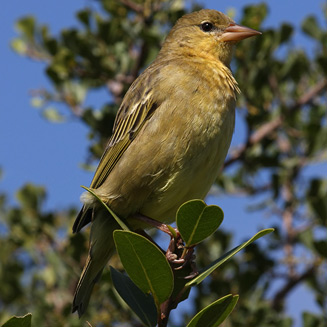 |
| Cape Weaver male, De Hoop Nature Reserve, Western Cape,
South Africa. [photo
Duncan Robertson ©] |
Cape Weaver female, De Hoop Nature Reserve, Western Cape,
South Africa. [photo Duncan Robertson ©] |
Distribution and habitat
Endemic to South Africa, Lesotho and Swaziland, occurring
across much of the area excluding the Kalahari Desert, generally preferring open
grassland, lowland fynbos, coastal thicket and farmland, provided they have
permanent water and trees.
|
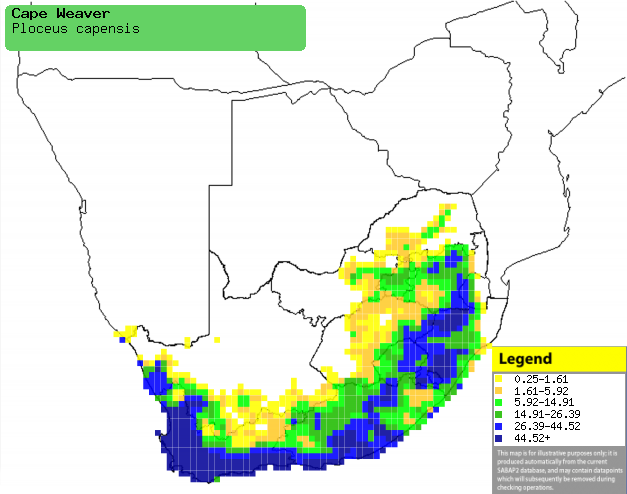 |
|
Distribution of Cape weaver in southern Africa,
based on statistical smoothing of the records from first SA Bird Atlas
Project (©
Animal Demography unit, University of
Cape Town; smoothing by Birgit Erni and Francesca Little). Colours range
from dark blue (most common) through to yellow (least common).
See here for the latest distribution
from the SABAP2. |
Predators and parasites
It (at various stages of development) has been recorded as
prey of the following animals:
Nest are sometimes heavily infested with mites, and
fledglings are sometimes parasitised by ticks.
Brood parasites
It has been recorded as host of the
Diderick
cuckoo.
Food
Omnivorous, as its diet it is pretty much equally split
between arthropods and plant matter, especially seeds, fruit and nectar. It
forages on the ground and in tree foliage, gleaning food from crevices in bark
and hawking insects aerially. The following food items have been recorded
in its diet:
- Arthropods
- Plants
- seeds
- Acacia cyclops (Rooikrans)
- Ehrhata (veldt grass)
- barley
- wheat
- maize
- peas
- pine (Pinus) nuts
- fruit
- Ficus (wild figs)
- Lycium ferocissimum (Snake-berry)
- Olea europea (African olive)
- figs
- apricots
- grapes
- nectar
- Aloe
- Agave
- Erythrina (coral-trees)
- Salvia africana-lutea (Brown sage)
- Schotia brachypetala (Weeping boer-bean)
- Grevillea robusta (Silky oak)
- whole flowers
- Tecoma capensis (Cape honeysuckle)
- Strelitzia regina (Crane flower)
- Human food, such as bread crumbs.
Breeding
- Polygynous, territorial colonial nester, as males may have up to 7 female
in one breeding season, usually living together in colonies of about 2-20
males. Each builds multiple nests within a small territory, which it
vigorously defends against intruders. Females test how a sturdy a nest is by
pulling at material in the inside; if it is accepted the female adopts a
hunched posture in readiness for mating (see image below).
- The nest (see images below) is built solely by the male in about 7 days,
consisting of a kidney-shaped, fully waterproof structure made of woven
broad strips of grass or reeds. If the female accepts it the male builds a
vertical entrance tunnel at the base, while she lines the interior with fine
grass and feathers. It is typically attached to the tip of a tree branch,
especially of a Eucalyptus or willow (Salix), or alternatively
in a bank of reeds (Phragmites) or Bulrushes (Typha capensis),
on telephone lines or in in fences overlooking water.
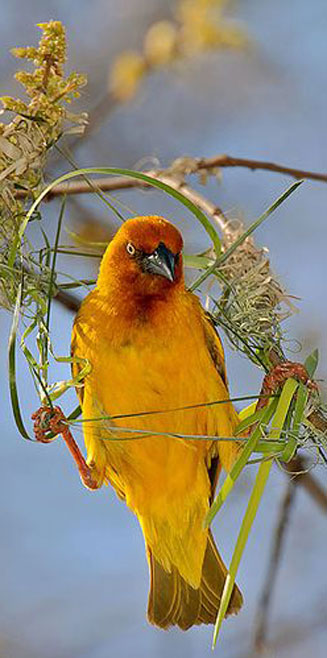 |
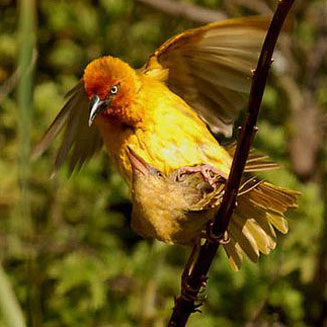 |
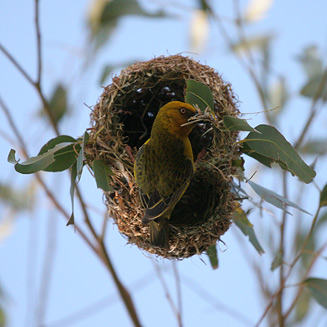 |
| Cape weaver building its nest, South
Africa. [photo
Callie de Wet ©] |
Top right: Cape weavers mating, South
Africa. [photo
Callie de Wet ©]
Bottom right: Cape Weaver male at
nest in a Eucalyptus tree, Kleinmond, Western Cape,
South Africa. [photo Duncan Robertson ©] |
- Egg-laying season is from June-February, peaking from October-January in
summer rainfall areas, earlier from August-October in the Western Cape.
- It lays 2-5 eggs, which are incubated solely by the female for about
13-14 days.
- The chicks are brooded by the female for the first few nights of their
lives, after which she roosts in an adjacent unused nest. They are initially
fed mainly by the female, but later the male takes a greater role in
providing food; the young leave the nest at about 17 days old.
Threats
Not threatened, in fact it is common and a pest to the
orchards and croplands of the Western Cape, where it is sometimes killed in
large numbers.
References
-
Hockey PAR, Dean WRJ and Ryan PG 2005. Roberts
- Birds of southern Africa, VIIth ed. The Trustees of the John Voelcker
Bird Book Fund, Cape Town.
|
